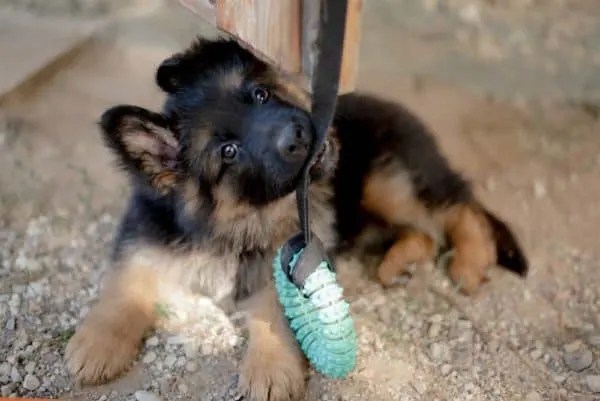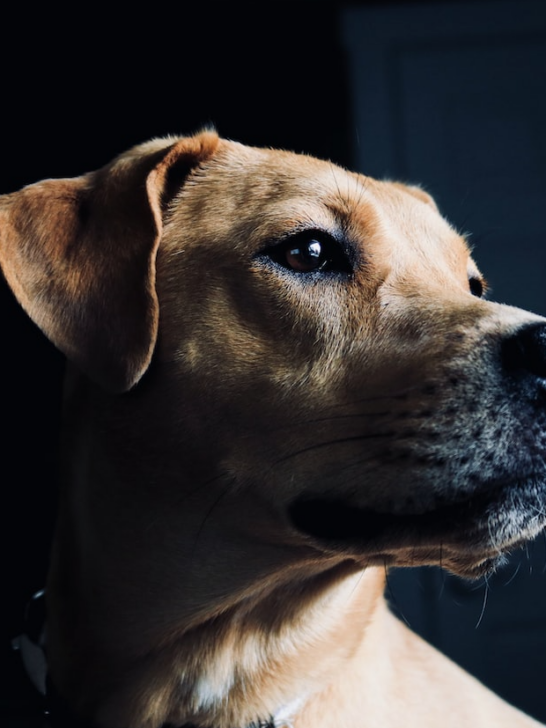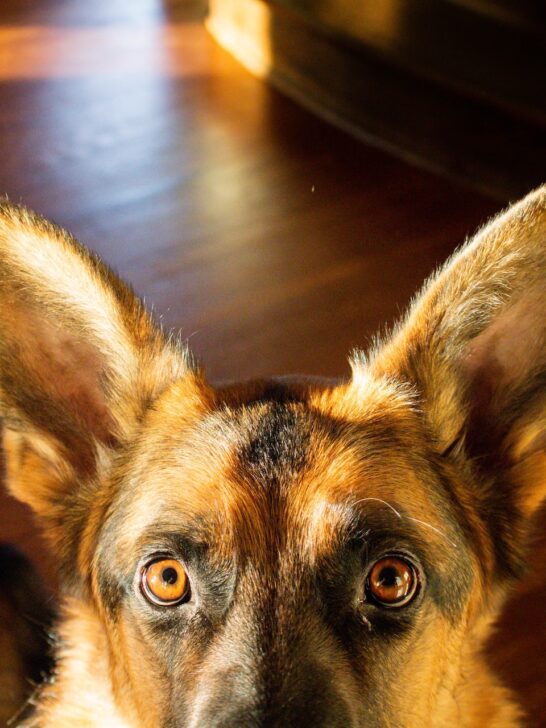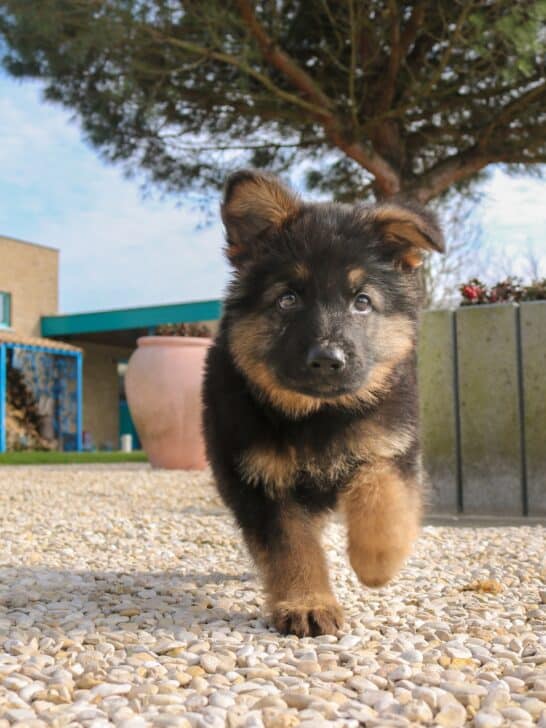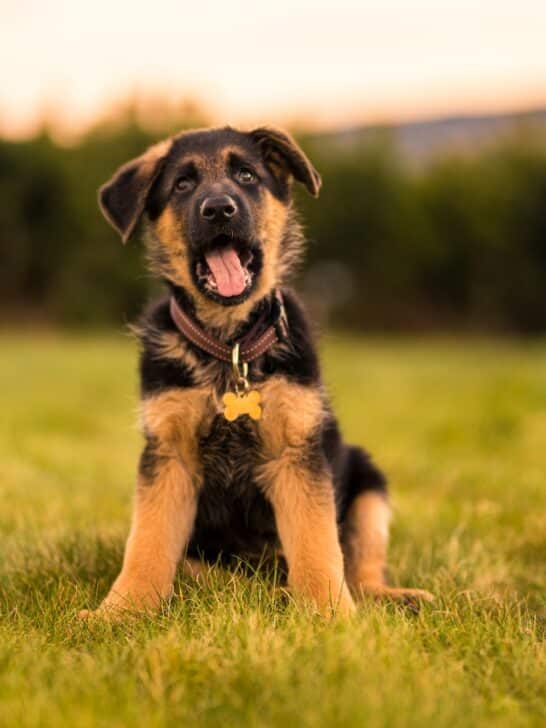6 Week Old German Shepherd: What to Know, What to Expect
The German Shepherd is one of those dog breeds that nearly everyone can name just by sight.
Their distinctive alert ears, intelligent faces, and rangy bodies speak to this breed’s bravery, strength, speed, and smarts.
But the German Shepherd as a six-week-old puppy is quite a different dog from a fully grown adult German Shepherd!
German Shepherd puppies are just like any other puppies – cute, roly-poly, frequently clumsy, and needing lots of daily attention and care from their moms and human caregivers.
In this article, find out everything you need to know about the German Shepherd dog at six weeks old, including how to select your puppy from a litter of German Shepherd puppies.

6 Week Old German Shepherd
At the age of six weeks old, a German Shepherd puppy should still be with the mom and littermates, as Lara’s Canine Solutions explains.
This is vitally important for early socialization and training purposes since the mother dog and littermates will naturally help the puppy to develop certain important canine etiquette and social skills they will use for the rest of their life.
Any reputable German Shepherd breeder will not release a puppy to their new forever home before the age of eight weeks at the earliest.
Watch a Six Week Old German Shepherd Puppy Grow Up
In this adorable YouTube video, the owner of a six-week-old German Shepherd puppy shares video footage of their puppy growing up to the age of four months.
Isn’t it amazing how quickly these tiny puppies can grow and change? In such a short space of time, a tiny puppy is replaced by a nearly full-grown adult dog!
A Brief History of the German Shepherd Dog
According to the American Kennel Club (AKC), the German Shepherd is the second most popular dog breed in the whole United States!
Considering that the AKC currently has 196 breeds registered, this is a pretty amazing ranking!
But German Shepherds didn’t start out as the companion canine of choice for families.
In fact, these dogs were developed by a former German cavalry captain named Max von Stephanitz. His goal was to create the perfect herding dog.
As the German Shepherd Dog Club of America (GSDCA) recounts, German Shepherds reportedly evolved from a half-dog/half-wolf hybrid of unknown lineage.
Captain von Stephanitz founded the breed club and kept a watchful eye over the development of the breed for decades until his death in 1899.
Anti-German sentiment after World War I caused a temporary decline in the German Shepherd dog’s popularity.
In the United Kingdom, breed enthusiasts successfully lobbied to change the breed name to the Alsatian Wolf Dog, according to the German Shepherd Rescue Elite charity.
But in 1977, UK breeders changed the name back to the German Shepherd. Today, German Shepherds are still called by Captain von Stephanitz’s original name, Deutscher Schäferhund, in Germany.
Everywhere else around the world, the name that is most commonly used is simply the German Shepherd.
People love the German Shepherd for their loyalty, strength, intelligence, athleticism, playfulness, beauty, and bravery.
German Shepherds are arguably the most in-demand dogs for K-9 work in the military, police force, private security, and personal protection.
A Timeline of German Shepherd Puppy Growth From Birth to Six Weeks Old
In this section, we will take you on a lovely tour of how German Shepherd puppies grow and develop from birth to the age of six weeks old.
Birth
Birth, or whelping as it is called for canines, is a big process for a puppy to go through and an even bigger job for the mother dog, as Kennels von Lotta German Shepherds breeder points out.
Most German Shepherd dog moms give birth naturally. If all goes well, the mother dog whelps each puppy, removes them from the placental sack, and licks them clean.
This process continues until all the puppies are born.
As soon as the puppies are born, the mother has to nurse them. When that is done, she has to lick them to get them to pee and poop.
And after that, she has to cuddle with them to keep them warm while they sleep.
German Shepherd puppies are born blind and deaf. Their only active senses are touch and smell.
One week old
By the age of one week (seven days), a German Shepherd puppy will have doubled in weight.
More excitingly, their eyes and ears will have begun to open, according to VomGeliebtenHaus German Shepherds breeder.
Regardless of what their coat coloration and eye color will be in adulthood, all German Shepherd puppies typically are born with all-black coats and blue eyes.
However, these still-tiny puppies won’t really be able to use their eyes yet – they will be able to perceive movement but anything they see will be out of focus.
Interestingly, experienced German Shepherd breeders say that it is easy to see individual personality traits starting even at one week of age.
Two weeks old
By the age of two weeks old, the little puppy’s eyes are starting to figure out how to focus, and if that isn’t enough, their first teeth are beginning to grow in!
The incisors are typically the first teeth to show up and they are tiny and sharp.
The puppies are starting to explore a bit more and gain a little bit of control over their own elimination function. However, they are still very reliant on their mom.
Three weeks old
Three weeks is when it starts to get exciting to be a German Shepherd puppy.
They start to look less like marionette puppets and more like dogs, walking with at least a semblance of coordination and jumping around and playing with their littermates.
They can hear well and see much more clearly. This is usually when breeders begin active socialization with people so the puppies will be comfortable with being handled and played with.
Four weeks old
By the age of four weeks old, the puppies are starting to engage in serious play, including mock fighting and games.
They begin to look a lot more like the adult dogs they are yet to become and gain greater independence from the mother dog.
This is also the age when puppies will start to eat soft or moist foods as a precursor to weaning off their mother’s milk.
To reflect this, the mother dog’s milk supply usually starts tapering off around this time.
Breeders sometimes call week four the “fearless stage” because the puppies are so keen to explore their new world.
Speaking of fearless, week four is when puppies have their full set of puppy teeth and their little puppy claws on top of that.
So it is not surprising the mother dog gets more forceful about establishing boundaries with the puppies this week. Those little claws and teeth are razor-sharp!
Five weeks old
German Shepherd dogs can easily produce litters of up to eight puppies, which is so cute and precious when the puppies are young.
But once those puppies start to get bigger and stronger and begin to eat more and eliminate more, this can mean a whole lot of cleanup for the mother dog and the breeder!
This is why five weeks old is the age that most breeders begin to introduce the concept of outdoor potty breaks.
Of course, it is still important to strictly monitor each puppy’s outdoor time carefully, since they are too young to have received all their protective vaccinations and pest treatments at this age.
Six weeks old
By the age of six weeks old, the puppies are finally old enough to start eating more solid foods and to get the first of their important vaccination treatments, distemper and parvovirus (and, optionally, Bordetella).
Six weeks old is also an important time for introducing strange people so the puppies get used to meeting and interacting with potential new owners.
The puppies are bigger and stronger now and are very curious and playful.
In a breeder setting, this is a time period when many puppies are “spoken for,” and we will address how to choose your German Shepherd puppy here shortly.
The German Shepherd Puppy “Fear Factor” Period
You may be reading through this guide and wondering why you can’t just take your new German Shepherd puppy home with you at six weeks old.
After all, your puppy is eating solid food, has all their puppy teeth and claws, is able to hear and see clearly, is playful and curious, and has been exposed to different people and socialized by their mom and littermates.
What could possibly go wrong?
The answer is simple: the “fear period” is yet to come.
All domestic dog puppies go through a period of time between the ages of eight to ten weeks that breeders and veterinarians call the “fear period.”
VCA Animal Hospitals explains that the fear period is actually extended from three weeks all the way to 12 weeks.
But for general purposes, canine researchers believe the most critical period happens between the age of six weeks and the age of 10 weeks, with specific fears taking shape around weeks eight through 10.
This is the time period when puppies begin to intensively socialize and interact with their littermates, human carers, and others, forming bonds or aversions as each situation or interaction may warrant.
As Dr. Jen’s Dog Blog points out, this period of time is incredibly important in a German Shepherd puppy’s development – so much so that fearful experiences during these two weeks can cause lifelong challenges.
This is one key reason why it is smart to work only with a GSD breeder that will not release puppies until after the tenth week.
This way, the puppy is able to move through the fear period in very familiar and trusted surroundings with the mom and littermates.
However, this is not to say that if you brought your German Shepherd puppy home when they were younger than 10 weeks old that you will have any problems.
Some puppies make it through the fear period just fine without any trauma.
But for puppies that do experience fearful or traumatic events during this two-week period, it may require special training throughout the dog’s lifetime to manage reactions to triggering circumstances or surroundings.
How to Manage the Fear Period for a Six Week Old German Shepherd Puppy
If you are preparing to welcome your new German Shepherd puppy into your family, you may be feeling justifiably worried about managing the fear period effectively.
After all, you won’t have any control over the experiences your young German Shepherd puppy may have had before they came to you.
But you certainly don’t want to accidentally traumatize or stress out your puppy to the point where behavior problems develop later on in life.
So is there anything you need to know or do to make sure your young puppy feels safe, secure, and loved right from day one of their new life with you?
As a matter of fact, there are some things you can do to set your puppy up for success right away.
Make sure everyone in your home spends time with the new addition
The first and most important component of welcoming your new German Shepherd puppy home is to make sure everyone in your family had equal “face time” with your new addition.
You will especially want to supervise young children to make sure they handle your puppy with appropriate sensitivity and gentleness.
A German Shepherd puppy that is properly socialized to the youngest family members will grow up to be a staunch guardian and protector to all.
Establish a consistent daily routine
For a young puppy, in particular, a consistent routine is key to comfort and feelings of safety.
And as a bonus, establishing a consistent routine is also the best way to help your young GSD puppy master house training, crate training, family sleep/wake cycles, new training commands, and the rhythm of daily life with you.
When your puppy learns that everything they need – meals, potty breaks, playtime, nap time – come at the same general time each day, this sends a clear signal that all is well and you and your family are trustworthy “pack” members.
While it can feel tempting to go easy for the first few days and just let your new puppy get settled in, this can actually be counterproductive to building your bond together.
A better strategy is to start every aspect of training from potty training to crate training to sleep training right away.
It is the difference between wading into the pool slowly hoping it won’t feel as cold versus just jumping in and warming up more quickly.
Your puppy will have come to you from a structured environment established by the mother dog and the breeder.
The more closely you can match and maintain that structure, making gradual adjustments as needed for your own daily life schedule, the more easily and quickly your puppy will adjust to life away from the litter and their mother.
Establish a baseline of health with daily habits and tracking
The other part of helping your puppy settle in quickly and happily is to start tracking your puppy’s health and growth right away.
Your German Shepherd breeder likely required you to take your new puppy for a veterinary checkup right away, and this will give you an excellent baseline against which to compare growth and development in the coming weeks.
Get into the habit of weighing and measuring your puppy each week and paying close attention to food and water intake, exercise and playtime, and sleep cycles.
Your veterinarian can help you learn how to start brushing your dog’s coat and teeth, cleaning their ears and inspecting the paw pads, trimming the nails, and squeezing the anal sacs and other routine maintenance tasks your puppy will need your help with.
This is also the best way to quickly identify if there are any emerging health issues that need your attention.
For example, if you see that your puppy’s weight has fallen off, this might be a sign to call your veterinarian for a health checkup.
Help Is Available When Caring for Your New 6 Week Old German Shepherd
German Shepherds are very smart, energetic, athletic, and affectionate dogs. This is why people love this breed so much.
But caring for a new puppy isn’t the easiest! Luckily, there is lots of help available.
Don’t be shy to reach out to your dog’s breeder, your veterinarian, local chapters of the German Shepherd dog club or experienced GSD K-9 trainers for help.
People who love the GSD breed are usually delighted to provide a new owner with assistance.















